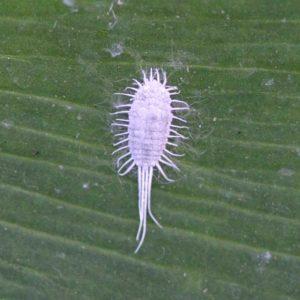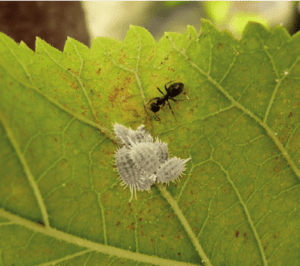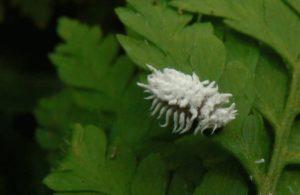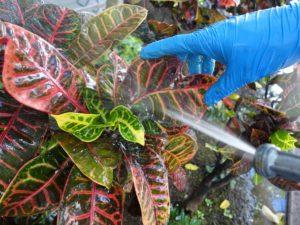Mealybug: photo and description of a pest of house plants
The mealybug can be safely called one of the most dangerous pests of indoor plants. The invasion of the parasite is fraught with sucking juices and inevitable death. At the first sign of defeat, it is necessary to start the fight against insects.
Content
What does a mealybug look like: photo
Description of the pest
Name: Mealybugs, feltworms
Latin: PseudococcidaeClass: Insects - Insecta
Squad: Hemiptera - Hemiptera
 | Habitats: | garden and vegetable garden, indoor plants |
 | Dangerous for: | green plants |
 | Means of destruction: | insecticides, folk methods |
In Europe, there are 330 varieties of the parasite. Habitats - the base of the leaves or their underside. Female and male individuals have a different appearance. It depends on the variety and stage of development. Some species are immobile. The rest move very fast.
Life cycle
Male and female individuals have different life cycles. In females, it consists of:
- eggs;
- nymphs;
- pseudopupa;
- an adult.
Females lay eggs in cotton-like egg sacs in which they themselves are. Eggs mature within 7 days. In some species, hatching of larvae occurs after laying.
Tramps are larvae capable of moving at high speed for prey. Passing through the next stage of molting, they begin to look for new food. After 1,5 months they become an adult.
The place of the life cycle of adults of some species is the soil. They feed on plant roots. The affected areas are found when the flowers are transplanted.
Males have 2 stages: egg and adults. The type of parasite affects life expectancy. Usually the period varies between 3-6 months. Females lay 300 to 600 eggs. Males live no more than one month.
In many species of mealybugs, reproduction occurs without the presence of males at all, so there are very few of them in the population.
Damage symptoms
Even the most attentive gardeners do not always notice the first signs of infection. Even though the mealybug is not the smallest of the houseplant pests. Only care will help keep the plant healthy. Of the signs worth noting:
- stop the growth of the flower;
- wilting, yellowing, leaf fall;
- curvature of young shoots;
- the presence of honeydew, honeydew, soot fungus;
- the formation of cotton balls in the lower parts of the stems.
mealybug diet
Different types of pest can feed on house flowers and plants in greenhouses or on the site. Harmful insects stick to the greenery and suck out all the juices from the plantings. The mealybug feeds on many indoor flowers:
- orchids;
- saintpaulia;
- cacti;
- azaleas;
- camellias;
- dracaena;
- palm trees;
- citrus fruits.
The pest enters the room with clothes and shoes, seedlings, unprepared land, through the window.
Mealybug: types
Most often, the mealybug population develops rapidly and rapidly in conditions with a warm, humid climate. Only a few species are often found on the territory of the Russian Federation.



Mealybug control methods
Many gardeners believe that folk remedies are ineffective. Therefore, most of them use chemical compositions. An excellent effect is given by this type of drugs. But when using them, you must be careful, apply according to the instructions and observing safety measures.
Chemicals
All drugs are divided into types according to the type of action. Substances can be:
- Contact - able to cope only with the larvae.
- Intestinal - when ingested, they provoke frustration and poisoning. The pests are dying.
- Systemic - distributed in plants without harming them. However, they are detrimental to the parasite at different stages of development.
Can be applied:
- Confidor, related to systemic insecticides;
- golden spark - has a nerve-paralytic effect;
- Aktar - the most common drug;
- admiral - refer to hormonal insecticides;
- Biotlin - with the active substance imidacloprid;
- Phytoverm - a biological preparation with aversectin.
Folk methods
This is a series of drugs that are based on plant materials. They must be prepared correctly, following recipes and proportions.
| Water and olive oil | A mixture of 2 liters of water with 2 tbsp. spoons of olive oil. The agent is sprayed with a spray bottle. |
| horsetail tincture | Alcohol is diluted 1: 1 with water, processing is carried out with a cotton swab. |
| Alcohol | 1 liter of water, 1 g of soap, 10 ml of alcohol. |
| Garlic | 6 slices are crushed and boiled in 0,5 liters of water |
| Citrus | 25 g of lemon and 25 g of orange peels are added to 1 liter of water and sprayed in a day. |
| Calendula | Dry flowers (100 gr) are poured into 1 liter of water, boiled and sprayed. |
| Hot water | To do this, the flower is taken out of the flowerpot, the roots are cleaned and dipped for 10 minutes in water with a temperature of about 50 degrees. Then they are dried and planted in fresh, disinfected soil. |
Mealybug Treatment Tips
In order for treatments to be of practical use, they must be carried out correctly. A few recommendations that are collected from the experience of gardeners:
- when the first symptoms appear, the plant must be isolated;
- before using systemic insecticides, insects are mechanically removed;
- remove infected plants if it is not difficult to save;
- test the flower for the drug, processing a small part of the leaf;
- the treatment is repeated after 5 days, changing the substance;
- wash with soapy water any surface that was nearby;
- small insects are washed off with a toothbrush with methyl alcohol.
Prevention
It is much easier to carry out prevention than to subsequently treat green pets from infection with insects and diseases that they spread. Preventive measures consist of:
- Regular inspection of plants.
- Periodic spraying or showering
- Disinfection of soil, organic, inorganic components, drainage components, pots, stands during planting.
- Timely removal of dried leaves, shoots, branches, buds.
- Compliance with the regime of watering and top dressing.
- Placing new flowers in another flowerpot and away from other flowers for 14 days.
Сonclusion
To prevent the invasion of the mealybug, prophylaxis is carried out. When symptoms of a lesion are detected, they begin to fight the parasite so that the plant does not die. The right method will help to cope with the insidious pest.
Previous
